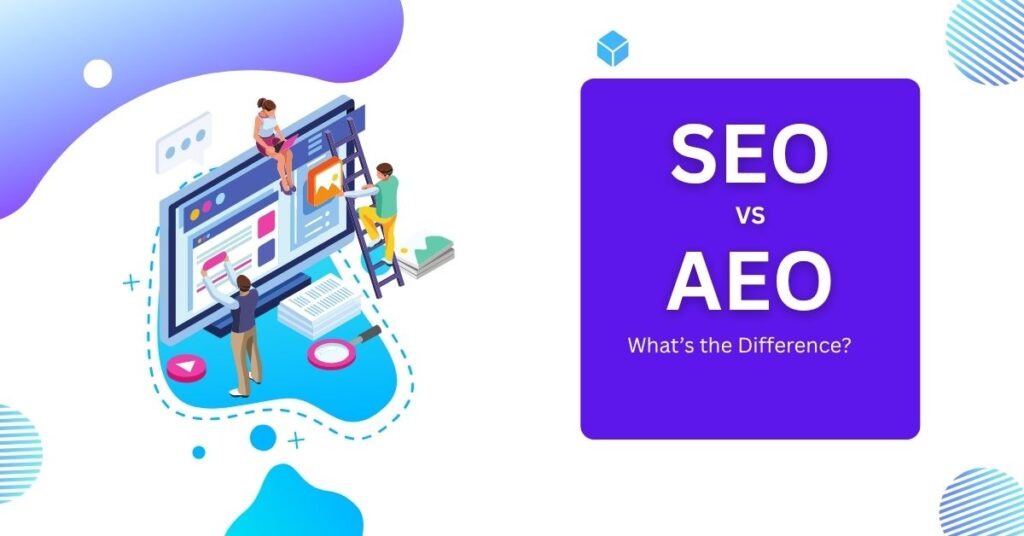Google SEO vs AEO: Understanding the Key Differences

Digital marketing continues to evolve, bringing with it new tools and approaches for reaching audiences. One comparison that marketers increasingly deal with is the difference between Search Engine Optimization (SEO) and Answer Engine Optimization (AEO).
While SEO has been a powerhouse for over two decades, focusing on making websites discoverable on search engines like Google, AEO represents the next step, catering to smart assistants like Siri, Alexa, or Google Assistant to ensure your content is the answer users get when they ask their devices a question.
But how do these two strategies differ? Which approach should you invest in more? By the time you finish this blog, you’ll have a clear understanding of SEO and AEO, their unique characteristics, and how you can use both to stay ahead in the competitive digital space.
What is Search Engine Optimization (SEO)?
At its core, SEO focuses on optimizing websites to rank higher on search engine results pages (SERPs). This is no small feat, as Google alone processes approximately 8.5 billion searches every day according to Internet Live Stats.
Here’s how SEO works and why it’s been a staple of digital marketing for years.
Key Features of SEO
- Keyword Targeting
SEO relies on targeting specific keywords users type into search engines. For instance, if someone searches for “best running shoes,” websites optimized with those keywords have a higher chance of appearing on the first page of SERPs.
- On-Page Optimization
On-page SEO practices like optimizing meta titles, headings, alt text for images, and internal links make websites clearer and more attractive to search engines.
- Backlink Building
Search engines, especially Google, see backlinks as a vote of authority. The more high-quality links you have pointing back to your website, the greater your chances of ranking higher.
- Content Creation
Long-form blog posts, tutorials, and evergreen content are fundamental to SEO. High-quality, relevant content remains one of the strongest ranking factors.
While these SEO practices help businesses improve visibility, the goal is clear—to capture users typing explicit queries into a search engine. But how does SEO stack up when users aren’t typing at all and are instead asking? That’s where AEO comes in.
What is Answer Engine Optimization (AEO)?
Unlike SEO, which focuses on ranking websites, AEO (Answer Engine Optimization) aims to optimize content to be the specific answer provided by voice assistants, smart devices, and even position zero on Google’s SERP.
Have you asked Alexa, “What’s the weather today?” or told Google Assistant, “Find the best budget camera under $100”? If a brand’s content is optimized for AEO, it’s more likely to be the answer offered by these tools.
Here’s how AEO works.
Key Features of AEO
- Conversational Keywords and Queries
Unlike short-tail keywords used in SEO, AEO responds to longer, more conversational phrases. For example, “Best Italian restaurant near me” or “How to bake sourdough bread without a starter” mimic how people naturally speak.
- Structured Data and Schema Markup
AEO relies heavily on structured data (schema markup) to help search engines understand the context of your content. By marking up elements like your address, recipes, or FAQs, you make it easier for AI assistants to extract relevant answers.
- Featured Snippets and Position Zero
For search engines like Google displaying an answer box, which is commonly known as “position zero,” your content should directly and concisely address questions. This makes it likelier for assistants to cite your content out loud.
- Relevance Over Depth
AEO prioritizes extracting short, precise answers rather than extensive blog posts. This often means focusing on providing quick and actionable answers within your content.
For businesses, AEO represents an exciting opportunity to dominate voice search and stay visible in an increasingly screenless world. But should it take precedence over SEO?
SEO vs AEO: Key Differences
Here’s a side-by-side breakdown to clarify the nuances between SEO and AEO.
|
Aspect |
SEO |
AEO |
|---|---|---|
|
Primary Focus |
Ranking websites on SERPs |
Providing precise answers for voice or direct queries |
|
Keyword Targeting |
Short-tail and long-tail keywords |
Conversational and question-based phrases |
|
Favored Format |
Long-form, detailed content (blogs, guides) |
Short, concise answers (FAQs, snippets) |
|
Optimization Tool |
On-page SEO, backlinks |
Schema markup, featured snippets |
| Device Focus | Primarily desktops and mobile screens | Voice assistants, IoT devices |
Why Should Businesses Use Both?
The great news is that SEO and AEO don’t compete—instead, they complement each other. When you optimize your website for SEO, you also lay a strong foundation for AEO. For instance, structured data not only boosts your chances of landing in position zero but also helps with AEO by providing clear answers to search engines.
Here’s a breakdown of why investing in both makes sense.
SEO’s Strengths
- Broader Visibility
Search engines remain the go-to solution when users want detailed information, not just a quick answer. Ranking high on SERPs builds brand authority and drives traffic to your website.
- Content Impact
The extensive information required for SEO aligns with content marketing, helping users understand your expertise while boosting your rankings.
- Revenue Funnel
Optimized blogs or landing pages create a direct sales pipeline, converting visitors into paying customers through CTAs.
AEO’s Strengths
- Voice Search Growth
According to Statista, by 2024, an estimated 8.4 billion voice assistant devices will be in use globally. AEO puts you at the center of this growing trend.
- Local SEO Boost
Smart devices favor location-based queries like “nearest coffee shop,” making AEO crucial for local businesses.
- Anticipatory Searches
Voice assistants thrive on predictive scenarios. AEO lets businesses align with customer intent before it’s fully articulated.
How to Optimize for SEO and AEO
Now that you know their benefits, here are actionable steps for leveraging both SEO and AEO in your strategy.
For SEO
- Perform thorough keyword research with tools like Ahrefs, SEMrush, or Google Keyword Planner.
- Create high-quality, long-form content centered around your audience’s biggest challenges.
- Use compelling meta tags and descriptions for every page of your site.
- Build a robust outreach strategy to earn backlinks from authoritative domains.
For AEO
- Start incorporating natural, conversational phrases into your content, especially FAQs.
- Implement schema markup on your pages to help search engines contextualize your data.
- Focus on creating short answers alongside detailed blogs to land featured snippets.
- Keep content updated and concise to maintain relevance over time.
Future-Proof Your Business with SEO and AEO
The digital landscape is evolving rapidly, but SEO and AEO ensure your visibility stays intact across both traditional search engines and emerging technologies. Whether your audience is typing a query or asking their voice assistant, your brand can stand out with the right optimizations.
Start with a blend of both approaches and experiment with strategies that align with your goals. The key is balancing detailed content that ranks with concise answers that dominate voice search.
Want expert help optimizing your content for SEO and AEO? Reach out to us today and take the first step toward future-ready visibility.
You can learn about: What Is AEO & Why It’s the Future of Digital Success








